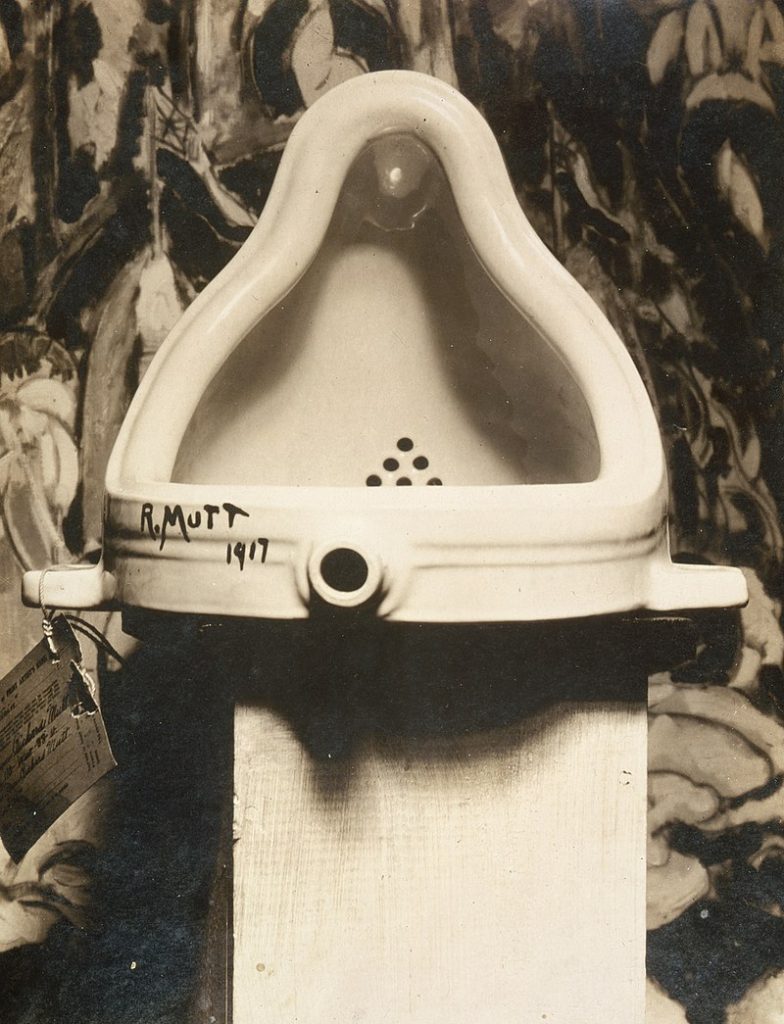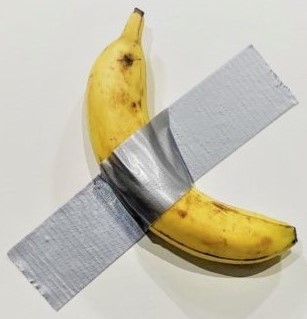Abhishek Kumar
There have been many artworks throughout history that have challenged the traditional norms of the art world and changed the way we think about art. Marcel Duchamp’s “Fountain”, Maurizio Cattelan’s “Comedian”, “Shredded Girl” by Banksy and Joseph Kosuth’s “One and Three Chairs” are some of the examples which changed the dynamics of the art world by challenging traditional notions of what constitutes art and by sparking discussions about the value and meaning of art. They also have questioned the authority of the art establishment and the commercialization of art.

Urinals, bananas, and shredders are all objects that can be considered “protectable art” in the right context. Urinals, for instance, can be considered art when they are used in a gallery setting, such as the famous Marcel Duchamp’s “Fountain”. Bananas can also be considered art when they are used as a medium, such as the work of Italian artist Maurizio Cattelan. Shredders can be used as a medium for art, such as the work by British artist Gustav Metzger. All of these objects can be considered protectable art if they are used in the right context and they are viewed as creative works of art.
Protectable art includes any artwork that is eligible for copyright protection. This could include paintings, drawings, photographs, sculptures, prints, and digital works. In order to be eligible for copyright protection, the artwork must be original and possess a certain degree of creativity. Additionally, the artwork must be fixed in a tangible medium of expression, meaning that it must be capable of being perceived, reproduced, or otherwise communicated for more than a transitory duration. Copyright protection is typically only available for works that are published or registered with the United States Copyright Office.
Marcel Duchamp’s “Fountain”

Marcel Duchamp is credited for pioneering the use of found objects and readymades in modern art. He was an early proponent of the idea that art can be made from anything, and his works challenged traditional notions of beauty and aesthetics. His influence has been far-reaching and has changed the way we view art today. Marcel Duchamp’s Fountain is a readymade sculpture created in 1917. It is a porcelain urinal signed “R. Mutt” and submitted for an exhibition at the Society of Independent Artists. The sculpture’s notoriety rests on the fact that it was rejected by Society on the grounds that it was not a work of art. The rejection of Fountain became a rallying point for the burgeoning Dada movement and is now seen as a seminal artwork of the 20th century. The fountain is widely regarded as a major landmark in the history of modern art and has had a profound influence on subsequent generations of artists.
Maurizio Cattelan’s “Comedian”

Maurizio Cattelan is best known for his humorous and often controversial works that challenge traditional ideas of art and art-making. Through his works, he has been able to bring attention to social issues and provoke thought and debate. His works have also become increasingly popular among the general public, making art accessible to a wider audience. Maurizio Cattelan’s sculpture “Comedian” is a symbolic piece, which has been interpreted in many different ways. The sculpture consists of a banana duct-taped to a wall, which some people have seen as a commentary on the art market or a critique of consumerism. Others have viewed the work as a commentary on society’s tendency to take things for granted, or as a joke about the absurdity of life. Whatever the interpretation, the work has become iconic in the art world, and has been seen as a symbol of resilience in difficult times.
Shredders by Metzger and Banksy

Gustav Metzger and Banksy are two British artists who have both engaged with the use of shredders in their artwork. Metzger is an artist who has been credited with helping to initiate the “Destruction in Art Symposium” in 1966, the first event of its kind. His work often deals with themes of destruction and renewal, and he has been influential in advancing the concept of “auto-destructive” art. Metzger was the first to use shredders in his art, employing them in the mid-1960s as a commentary on consumerism and the destruction of the environment. His work often featured large scale shredders that shred paper, wood, and plastic into strips. The shredded material was then used as an installation or in performances, as a way to draw attention to the destruction of our environment.
Banksy is an anonymous street artist who has become one of the most well known and influential artists of our time. His work often deals with political and social issues, and his subversive approach to art has become influential in many different parts of the world. Banksy also uses shredders in his artwork, such as in 2018 when he famously shredded his “Girl with Balloon” painting just moments after it sold for nearly $1.4 million at auction. This piece was a commentary on the commodification of art and the power of the market. He has also used them in other works such as for his “Dismaland” theme park installation and in his satirical “Shred the Love” sculpture.

Some of the other artworks that have pushed the boundaries of what is considered art and have played a key role in shaping the art world are “One and Three Chairs” by Joseph Kosuth consists of a photograph of a chair, a real chair, and a dictionary definition of a chair. It raises questions about the nature of art and the relationship between the object, its representation, and its meaning. Tracey Emin’s “My Bed” features the artist’s unmade bed, complete with soiled sheets, empty beer bottles, and used condoms. It explores themes of intimacy, vulnerability, and the personal as political. Felix Gonzalez-Torres “Perfect Lovers” is a series of clocks that hang on the wall and are set to the same time, This work is a representation of the love between two men and it challenges the traditional idea of art as a physical object by instead being a conceptual representation of the idea of love.
The artworks that have changed the dynamics of the art world have done so by introducing innovative approaches to art, challenging previous norms and conventions, and creating new forms of expression. They have pushed the boundaries of what is considered art, and have led to an increased interest in and appreciation of diverse forms of artistic expression. From Marcel Duchamp’s “Fountain” to “Shredded Girl” by Banksy, these artworks have revolutionized the way we view and interact with art. In doing so, they have helped to create a more open, inclusive and vibrant art world.
“Everything around us is an art, we just need the vision to look into that.” —- Writer





